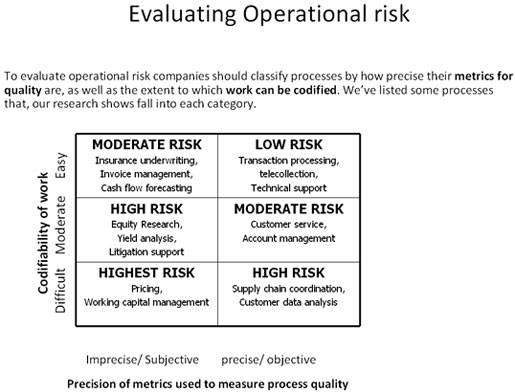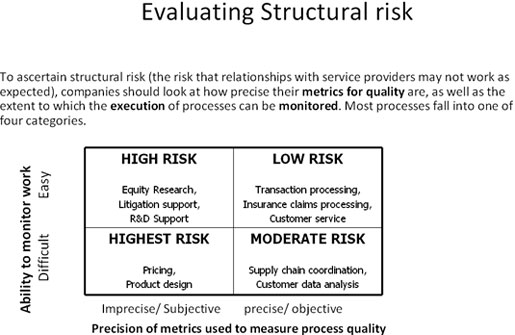

What are the real risks in offshoring both ITO and BPO work? Ravi Aron, assistant professor, Carey Business School, Johns Hopkins University and a research partner with the Wipro Council for Industry Research, says understanding those risks helps buyers set up procedures to mitigate them, making their offshore engagements more successful.
Aron, who is also a Senior Fellow at the Phyllis Mack Center for Technology and Innovation at the Wharton School of Business, The University of Pennsylvania, says there are three types of risks buyers must worry about:
Operational risk
Aron says operational risk is simply “getting output you don’t like. The quality is not there.” The output has too many errors, mistakes, and defects.
For example, in ITO, the application does not have all the functionalities that the buyer asked for. Or the code has bugs. Or there could be cost overruns or delays in delivering the system.
Turning to BPO, there could be mistakes in underwriting in insurance work. In call center outsourcing, the offshore provider of services does not achieve first-call resolution metrics; the buyer wants 80 percent but the supplier can manage only 60 percent. In supply chain outsourcing, the accounts receivable/accounts payment closures have too many errors.
“In all cases, the supplier’s quality is less than what’s mandated in the service level agreements (SLAs),” explains Aron.
The causes of operational risk

Source: Ravi Aron
Aron says the principal reason this risk exists is “because of the complexity of work. It takes a while for the offshore organization to understand what the buyer wants.”
Another reason operational risk occurs is because of business unfamiliarity. “I think the risk of cultural context unfamiliarity is overstated and the risk of business context unfamiliarity is understated,” says Aron. The professor says you can teach Indians why Americans love Halloween. “But few buyers estimate the real hazards of trying to transfer the business context.”
He gives an example. The offshore company manages the back-office corporate treasury function for a bank. The bank instructs the provider of services to reconcile the various invoices and then make payments to a corporate customer (a large retailer). The amount in question is about US$60 million of business receipts for the retailer. The bank has a reputation for speedy and accurate reconciliation, which helps in improving the float for its customers. This is a part of the bank’s value proposition: to help its customers get better working-capital management through improved management of its float.
However, the offshore supplier doesn’t understand the concept of float or why it’s important to these customers. So it transfers the $60 million a couple of days later than usual, causing the customers to lose the float on that amount. The bank’s customers are angry. The supplier just didn’t understand why a two-day delay was so much of a problem. “Business unfamiliarity can be a serious issue,” says Aron.
Managing operational risk
How do you manage operational risk? Aron says there are four ways to do this:
Structural risk
Structural risk is the result of opportunistic behavior, according to Aron. The supplier cuts corners or puts in less than the expected effort. Or the supplier insists the buyer pay for supplier mistakes.
Here are three ways suppliers do this:
Here are some real life examples. In claims underwriting, a property and casualty insurance company requires its supplier to check for 25 compliance factors. The supplier, however, cuts corners and only looks at 18-20 factors.
In ITO, a buyer signs a contract that promises that the provider’s veteran programmers and systems analysts will work on the project. But when work commences, the supplier replaces some of the experienced team members and sends rookies who cost a lot less.
These are examples of deliberate underperformance.
Here’s an example of opportunistic misuse of information. The supplier’s sales staff gets a bonus if its call center staff signs up a certain number of new credit card holders. To boost sales, the supplier’s staff offers the customers a lower APR than the buyer wants. Now the buyer has a lower yield on its card portfolio.
An example of opportunistic behavior typically happens after 18 months into a contract when the power shifts from the buyer to the supplier. The supplier suddenly demands a higher price for the contracted services or insists on lowering SLA levels, knowing it now has more bargaining power. “This clearly violates the spirit of the contract,” says the professor.

Source: Ravi Aron
Managing structural risk
Aron says there are four ways to manage structural risk:
The use of customer satisfaction criteria in addition to SLA-based metrics of output quality can drive significantly higher quality outcomes. The buyer tells the provider the buyer’s in-house managers are its customers; periodically the buyer will survey them, providing customer satisfaction scores (CSS). The CSS ratings determine a portion of the payment the buyer receives.
CSS scores cause the provider to “sense and respond” to the business context of the buyer. The provider understands that there are aspects of the relationship that the buyer can’t easily specify via a system of metrics but are nevertheless important. It invests in understanding the business context of the buyer and offers true relationship management.
The contractual governance of the relationship changes to a “sense and respond” mode of governance. For business transformation this is necessary; the provider must go beyond the routine delivery of services. In many BPO and ITO contracts that Professor Aron has studied over the past seven years in several countries, the contracts that incorporated CSS scores outperformed those that did not both in terms of the quality of work from the offshore provider and the buyers’ managers’ satisfaction with the offshore service center.
Composite risk
This risk is characterized by a deliberate erosion of competency in the buyer’s organization since it sent those skills abroad.
The extended organizational form
Aron says the extended organizational form (EOF) “contains in great measure all three risks.” The EOF “bridges the strengths of both organizations” by letting the provider’s employees report to the buyer’s management. “The buyer’s manager treats them as if they were its own employees,” explains Aron. While there is no direct employee relationship between the buyer and the provider’s employees, this allows the buyer to divest financial control while retaining operational control.
The buyer’s managers then monitor operations, inspect the quality after execution, and exert direct managerial control. “Surprisingly, it also provides operational benefits to the supplier,” says Aron. Over a period of time the provider’s costs fall without compromising the quality of work.
There is another reason to consider this form of offshoring. In the current environment there is some possibility of legislation that will discourage companies from offshoring work. That legislation may take the form of not allowing U.S.-based firms to take tax deductions for the operations of their captive centers offshore. The expense becomes fully tax deductible if the buyer outsources these operations.
Some firms may fear the loss of control that may result from outsourcing operations to a third-party company. This is where the EOF plays a role. It allows firms to exert operational and strategic control over their offshore operations without having to carry these expenses on their balance sheets. The EOF thus brings together the best features of both forms of governance: Outsourcing brings the discipline of the market to the cost of operations while captive centers give the client firm higher levels of strategic control. The EOF is subject to the discipline of the market even while it allows the client to exert strategic and operational control over the offshore service center.
In these difficult economic times, it provides a compelling rationale for offshore services. Combining the EOF with careful use of CSS criteria in contracts allows buyers to move towards transforming their offshore service providers into strategic partners.
Companies such as Wipro are taking up initiatives to address buyers whose objectives not only include cost savings but also making a strategic business impact. Wipro’s PACE initiative seeks to combine multiple business objectives including:

